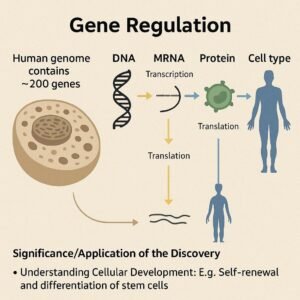BIOTECHNOLOGY
1 Genes and Related Concepts
About
This section introduces fundamental concepts in genetics, crucial for understanding biotechnology. It covers genes, DNA, RNA, chromosomes, and genome editing.
Key Points
-
Genes are segments of DNA that contain instructions for specific traits.
-
DNA is a nucleic acid that stores genetic information.
-
RNA plays a role in gene expression and protein synthesis.
-
Chromosomes are thread-like structures made of protein and DNA.
-
The genome is the complete set of DNA instructions in a cell.
-
Genome editing technologies like CRISPR-Cas9 allow for precise alterations to DNA sequences.
-
Genome editing differs from genetic engineering as it does not always involve the introduction of foreign genetic material.

Recent Developments
- Continued advancements in genome editing technologies are refining their precision and expanding their applications.
Impact
-
A strong understanding of these foundational concepts is essential for comprehending advances in biotechnology, personalized medicine, and genetic engineering.
-
Genome editing holds the potential to treat genetic diseases, improve agriculture, and advance our understanding of biology.
Challenges and Way Forward
-
Ethical considerations surrounding genome editing, including off-target effects and equitable access, need careful attention.
-
Further research is needed to fully understand the long-term consequences of genome editing and to develop safe and effective applications

2. Nobel Prize in Medicine 2024 (Gene Regulation)
Nobel Prize 2024 Highlights Crucial Role of microRNA in Gene Regulation
About
This section discusses the 2024 Nobel Prize in Physiology or Medicine, awarded for the discovery of microRNA and its role in gene regulation.
Key Points
-
The Nobel Prize was awarded to Victor Ambros and Gary Ruvkun
-
They discovered microRNA (miRNA) and its role in post-transcriptional gene regulation.
-
MicroRNAs are small, non-coding RNAs that regulate gene expression.
-
Gene regulation is the process that controls the timing, location, and amount of gene expression.
-
Reverse transcriptase is an enzyme that synthesizes DNA from an RNA template.
Timeline
-
1993: Discovery of microRNA and its role in gene regulation.
-
2024: Nobel Prize in Physiology or Medicine awarded to Victor Ambros and Gary Ruvkun.
Recent Developments
- Ongoing research continues to elucidate the diverse roles of microRNAs in various biological processes and their potential applications in medicine.
Impact
-
This discovery has significantly advanced our understanding of gene regulation and its importance in development, disease, and cellular processes.
-
MicroRNAs hold promise for diagnostic and therapeutic applications, including cancer and immune-related disorders.
Challenges and Way Forward
-
Further research is needed to fully understand the complex regulatory networks involving microRNAs and to develop targeted therapies.
-
The development of effective delivery systems for microRNA-based therapeutics remains a challenge.
3. Genetically Modified (GM) Crops
Understanding Genetically Modified (GM) Crops in India
About
This section focuses on genetically modified (GM) crops, particularly GM mustard, and the ongoing debate surrounding their use in India.
Key Points
-
The Supreme Court pronounced a split verdict on the environmental release of GM mustard.
-
GM mustard (DMH-11) is India’s first indigenously developed GM food crop.
-
Bt-Cotton is the only approved GM crop for commercial cultivation in India.
-
GM crops offer potential benefits such as enhanced yield protection, reduced pesticide use, and improved nutritional value.
-
India has a multi-layered regulatory framework for GM crops, including the GEAC, RCGM, SBCC, and DLC.
Recent Developments
- The debate surrounding GM crops continues in India, with ongoing discussions about their safety, environmental impact, and socio-economic implications.
Impact
-
GM crops have the potential to contribute to food security and agricultural sustainability.
-
However, concerns remain about their potential risks to the environment, human health, and biodiversity.
Challenges and Way Forward
-
A balanced approach is needed, carefully weighing the potential benefits and risks of GM crops.
-
Transparent and science-based regulatory processes are crucial for informed decision-making.
-
Public engagement and awareness are essential to address concerns and build trust in GM technology.
4. Heritable Human Genome Editing (HHGE)
Understanding Heritable Human Genome Editing (HHGE)
About
This section discusses Heritable Human Genome Editing (HHGE) and its potential implications.
Key Points
-
South Africa became the first country to allow Heritable Human Genome Editing (HHGE).
-
HHGE involves changes in germline cells (sperm, eggs, or embryos) that can be inherited by offspring.
-
Potential applications include disease prevention (e.g., Huntington’s disease, sickle cell anemia) and assisted reproductive technology.
-
Concerns exist about unforeseen consequences and the potential for “designer babies.”
Timeline
-
2024: South Africa allows Heritable Human Genome Editing (HHGE). https://www.ncbi.nlm.nih.gov/books/NBK447263/
Recent Developments
- The debate surrounding HHGE is intensifying, with discussions focusing on ethical guidelines and regulatory frameworks.
Impact
-
HHGE has the potential to eradicate inherited diseases but raises significant ethical and societal concerns.
-
It could revolutionize reproductive medicine but also lead to social inequalities and eugenics.
Challenges and Way Forward
-
International consensus is needed on the ethical principles and governance of HHGE.
-
Thorough risk assessments and long-term studies are crucial to ensure the safety and efficacy of HHGE.
-
Public dialogue is essential to address societal concerns and promote responsible innovation.
5 .RNA Edit
RNA Editing: A New Frontier in Genetic Medicine
About
This section explores RNA editing, a technique that modifies genetic information on RNA sequences.
Key Points
-
The first successful clinical demonstration of RNA editing in humans was conducted.
-
Wave Life Sciences performed RNA editing to treat alpha-1 antitrypsin deficiency (AATD).
-
RNA editing modifies genetic information on RNA sequences through insertion, deletion, or substitution.
-
RNA editing makes temporary changes, while DNA editing makes permanent changes.
Timeline
-
2024: First successful clinical demonstration of RNA editing in humans.
Recent Developments
- RNA editing is emerging as a promising therapeutic strategy for various genetic disorders.
Impact
-
RNA editing offers a potentially safer and more flexible alternative to DNA editing.
-
It has the potential to treat a wide range of diseases with fewer side effects.
Challenges and Way Forward
-
Efficient and targeted delivery of RNA editing tools remains a challenge.
-
Further research is needed to optimize RNA editing techniques and minimize off-target effects.
6 Bridge Recombinase Mechanism (BRM)
About
This section discusses the discovery of a naturally existing DNA editing tool called the Bridge Recombinase Mechanism (BRM).
Key Points
-
Scientists discovered the Bridge Recombinase Mechanism (BRM), a naturally existing DNA editing tool.
-
BRM utilizes mobile genetic elements or “jumping genes.”
-
Jumping genes are DNA sequences that move from one location on the genome to another.
-
BRM offers a flexible way to make DNA modifications.
Timeline
-
2024: Discovery of Bridge Recombinase Mechanism (BRM).
Recent Developments
- BRM represents a novel approach to gene editing with the potential for increased flexibility and precision.
Impact
-
BRM could expand the toolkit for gene editing and enable new therapeutic strategies.
-
Understanding the mechanisms of jumping genes could provide insights into genome evolution and disease.
Challenges and Way Forward
-
Further research is needed to fully characterize the BRM and optimize its use for gene editing.
-
The safety and efficiency of BRM-based gene editing need to be thoroughly evaluated.
7 . One Day One Genome
One Day One Genome: India’s Push for Microbial Genomics
About
This section discusses the ‘One Day One Genome’ initiative launched by the Department of Biotechnology (DBT) and the Biotechnology Research and Innovation Council (BRIC).
Key Points
-
The ‘One Day One Genome’ initiative aims to publicly release an annotated microbial genome every day.
-
The goal is to make microbial genomics data more accessible to researchers.
-
Microbial genomics studies the complete genetic material of microorganisms.
-
Studying microbes has significance for human health, biotech applications, environmental sustainability, and agriculture.
Timeline
2024: Launch of the ‘One Day One Genome’ initiative.
Recent Developments
- This initiative is expected to significantly boost microbial research in India.
Impact
-
Increased availability of microbial genomics data will accelerate research in various fields.
-
It can lead to new discoveries in medicine, industry, and environmental science.
Challenges and Way Forward
-
Ensuring data quality, standardization, and accessibility is crucial.
-
Developing infrastructure and expertise for analyzing large genomic datasets is essential.
8. Gene Therapy
Gene Therapy: The Promise of Healing at the Genetic Level
About
This section provides an overview of gene therapy, a technique for treating or preventing diseases by using genes.
Key Points
-
Gene therapy involves inserting a normal gene into the genome to compensate for a disease-causing gene.
-
Types of gene therapy include germline gene therapy (modifying germline cells) and somatic cell gene therapy (modifying somatic cells).
-
Gene therapy has the potential to treat both inherited and acquired disorders.
Recent Developments
- Advances in gene delivery and gene editing technologies are improving the safety and effectiveness of gene therapy.
Impact
-
Gene therapy offers the potential to cure previously untreatable genetic diseases.
-
It is also being explored for treating cancer, infectious diseases, and other conditions.
Challenges and Way Forward
-
Developing safe and efficient gene delivery systems is a major challenge.
-
Long-term safety and efficacy need to be carefully evaluated.
-
Ethical considerations surrounding gene therapy, especially germline gene therapy, require careful attention.
9.Chimeric Antigen Receptor (CAR) T-Cell Therapy
CAR T-Cell Therapy: A New Weapon in the Fight Against Cancer
About
This section discusses Chimeric Antigen Receptor (CAR) T-cell therapy, a form of immunotherapy used to treat cancer.
Key Points
-
India launched its first homegrown CAR T-cell therapy, NexCAR19.
-
CAR T-cell therapy involves modifying a patient’s T-cells to target and kill cancer cells.
-
CAR T-cells are considered a “living drug.”
-
This therapy can offer long-term cancer treatment and potentially cure specific cancers.
-
Challenges include cancer-type specificity and potential side effects.
Timeline
-
2024: Launch of India’s first homegrown CAR T-cell therapy, NexCAR19.
Recent Developments
-
CAR T-cell therapy is showing remarkable success in treating certain blood cancers.
-
Research is ongoing to expand its application to other types of cancer and to reduce side effects.
Impact
- CAR T-cell therapy represents a major breakthrough in cancer treatment, offering new hope for patients with relapsed or refractory cancers.
Challenges and Way Forward
-
The high cost of CAR T-cell therapy limits its accessibility.
-
Managing potential side effects, such as cytokine release syndrome, is crucial.
-
Developing CAR T-cell therapies for solid tumors remains a significant challenge.
10.Stem Cells
Stem Cells: The Body’s Master Cells and Their Therapeutic Potential
About
This section discusses stem cells and their potential for treating various diseases.
Key Points
-
Stem cells have the unique ability to develop into specialized cell types.
-
They can divide to produce new cells and replace damaged cells.
-
Stem cells can be derived from embryos or adult tissues.
-
Types of stem cells include totipotent, pluripotent, multipotent, and unipotent.
-
Stem cell therapy has shown promise in treating conditions like type 1 diabetes.
Timeline.
-
2024: A Type 1 diabetic woman was treated using cells derived from her own body after a reprogrammed stem cell transplant
Recent Developments
- Stem cell research is rapidly advancing, with new techniques for generating and manipulating stem cells.
Impact
- Stem cell therapy holds the potential to regenerate damaged tissues and organs, offering new treatments for a wide range of diseases.
Challenges and Way Forward
-
Ethical concerns surrounding the use of embryonic stem cells need to be addressed.
-
Controlling stem cell differentiation and preventing unwanted tissue growth are crucial.
-
Further research is needed to fully understand the mechanisms of stem cell therapy and optimize its effectiveness.